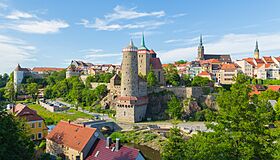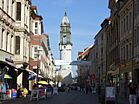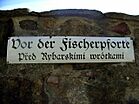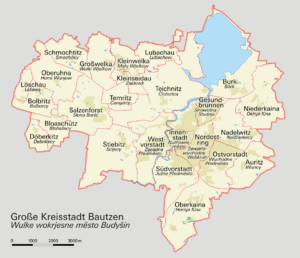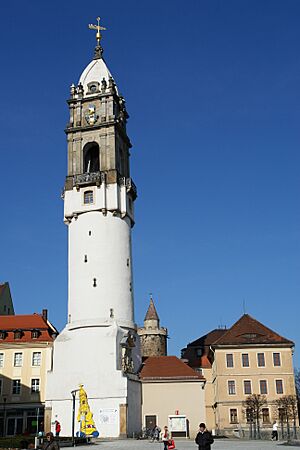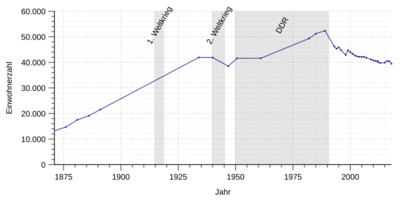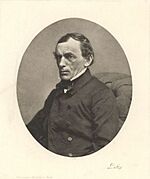Bautzen facts for kids
Quick facts for kids
Bautzen
Budyšin |
||
|---|---|---|
|
Clockwise from top: view of Bautzen, view over the city hall to the Czorneboh (Lusatian Highlands), historicizing bilingual Bautzen street signage, view of the city at dusk, Reichenturm, Main Market Square with town hall
|
||
|
||
|
Location of Bautzen
Budyšin within Bautzen district 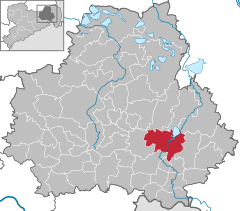 |
||
| Lua error in Module:Location_map at line 530: Unable to find the specified location map definition: "Module:Location map/data/Germany Sachsen" does not exist. | ||
| Country | Germany | |
| State | Saxony | |
| District | Bautzen | |
| Subdivisions | 15 | |
| Area | ||
| • Total | 66.62 km2 (25.72 sq mi) | |
| Elevation | 204 m (669 ft) | |
| Population
(2022-12-31)
|
||
| • Total | 38,140 | |
| • Density | 572.50/km2 (1,482.77/sq mi) | |
| Time zone | UTC+01:00 (CET) | |
| • Summer (DST) | UTC+02:00 (CEST) | |
| Postal codes |
02625
|
|
| Dialling codes | 03591 | |
| Vehicle registration | BZ, BIW, HY, KM | |
Bautzen (also called Budyšin in Sorbian) is a historic town in eastern Saxony, Germany. It's the main city of the Bautzen district. The town is located on the Spree River. It's the eighth largest town in Saxony and the center of Saxony's biggest district.
Bautzen is in an area where two languages are spoken: German and Sorbian. This area is called Lusatia. Bautzen is the third largest town in Lusatia, after Cottbus and Görlitz. It's also the second largest town in Upper Lusatia.
The town sits in a hilly area called the Upper Lusatian Gefilde. This area is part of the Sudetes mountains. Bautzen is the first big town you reach on the Spree River. The Bautzen Reservoir is just north of the town. In 2021, about 38,000 people lived in Bautzen.
Even though Görlitz is bigger, Bautzen is seen as the historical capital of Upper Lusatia. It's the main place for the Sorbs, a Slavic minority group in Germany. About 10% of people in Bautzen speak Upper Sorbian. The Sorbian language is used more in the countryside around the town than in the town itself. Bautzen is home to many Sorbian groups, like the Domowina (a Sorbian organization), the German-Sorbian People's Theater, and Sorbian Broadcasting.
From 1346 to 1815, Bautzen was part of the Lusatian League, a group of six important towns. Bautzen also has "Germany's oldest Christmas market mentioned in a chronicle," called the Wenceslaus' Market. There's even an Asteroid named after the city, 11580 Bautzen.
Contents
Town Names
Like many places in Lusatia, Bautzen has different names in different languages. Its German name was officially changed in 1868.
Besides Bautzen (German) and Budyšin (Upper Sorbian), the town has also been called:
- In German: Budissin (used until 1868)
- In Lower Sorbian: Budyšyn
- In Czech: Budyšín
- In Polish: Budziszyn
Where is Bautzen?
Location
The town is on the Spree River. It's about 50 kilometers (31 miles) east of Dresden. Bautzen is located between the Lusatian highlands and the flatlands to the north. It's right in the middle of the Upper Lusatia region. To the north, you'll find the Bautzen Reservoir, which was created in 1974. This reservoir covers the old villages of Malsitz and Nimschütz.
How the Town Grew
The oldest part of Bautzen is on a high area above the Spree River. The Ortenburg castle sits at the very top of this area. The old town is surrounded by city walls. Newer parts of the town were built later to the east. After the city walls were removed, the town grew even more to the east and across the river. However, not much of the town is west of the Spree River. In the 1970s, new areas like "Gesundbrunnen" and "Allendeviertel" were built. After 1990, several nearby villages became part of Bautzen.
Neighboring Towns
Bautzen is surrounded by several towns and villages. To the north are Radibor, Großdubrau, and Malschwitz. To the east is Kubschütz. To the south are Großpostwitz, Obergurig, and Doberschau-Gaußig. To the west is Göda. All these places are in the Bautzen district.
Town Parts
Bautzen is divided into 15 city districts. Here are some of them:
| Name | Population (as of 1 January 2009) |
||
|---|---|---|---|
| German | Upper Sorbian | English translation | |
| Innenstadt | Nutřkowne město | City centre | 5,278 |
| Südvorstadt | Južne Předměsto | Southern outskirts | 1,738 |
| Westvorstadt | Zapadne Předměsto | Western outskirts | 3,505 |
| Gesundbrunnen | Strowotna studnja | – | 8,178 |
| Nordostring | Sewjerowuchodny Wobkruh | North-eastern ring | 10,727 |
| Ostvorstadt | Wuchodne Předměsto | Eastern outskirts | 6,360 |
| Teichnitz | Ćichońca | – | 377 |
| Nadelwitz | Nadźankecy | – | 268 |
| Burk | Bórk | – | 325 |
| Oberkaina | Hornja Kina | – | 832 |
| Niederkaina | Delnja Kina | – | 522 |
| Stiebitz | Sćijecy | – | 510 |
| Kleinwelka | Mały Wjelkow | – | 1,314 |
| Salzenforst-Bolbritz | Słona Boršć-Bolborcy | – | 839 |
| Auritz | Wuricy | – | 458 |
Bautzen's History
Duchy of Poland 1002-1025
![]() Kingdom of Poland 1025–1032
Kingdom of Poland 1025–1032
![]() Margraviate of Meissen 1032-1075
Margraviate of Meissen 1032-1075
![]() Duchy of Bohemia 1075–1198
Duchy of Bohemia 1075–1198
![]() Kingdom of Bohemia 1198–1253
Kingdom of Bohemia 1198–1253
![]() Margraviate of Brandenburg 1253-1319
Margraviate of Brandenburg 1253-1319
![]() Kingdom of Bohemia 1319-1469
Kingdom of Bohemia 1319-1469
![]() Kingdom of Hungary 1469-1490
Kingdom of Hungary 1469-1490
![]() Kingdom of Bohemia 1490-1635
Kingdom of Bohemia 1490-1635
![]() Electorate of Saxony 1635–1806
Electorate of Saxony 1635–1806
![]() Kingdom of Saxony 1806-1871
Kingdom of Saxony 1806-1871
![]() German Empire 1871-1918
German Empire 1871-1918
![]() Weimar Republic 1918-1933
Weimar Republic 1918-1933
![]() Nazi Germany 1933-1945
Nazi Germany 1933-1945
![]() Allied-occupied Germany 1945-1949
Allied-occupied Germany 1945-1949
![]() East Germany 1949–1990
East Germany 1949–1990
![]() Germany 1990–present
Germany 1990–present
People have lived in the Bautzen area since the late Stone Age. In the 3rd century AD, a Germanic group settled here. Then, in the 6th century AD, the Sorbs arrived.
The first time Bautzen was mentioned in writing was in 1002, under the name Budusin. In 1018, an important agreement called the Peace of Bautzen was signed here. This agreement kept the town under Polish rule. Over time, Bautzen was ruled by different groups, including the Duchy of Bohemia and later the Kingdom of Bohemia. In 1635, it became part of Saxony. One of the main roads connecting Warsaw and Dresden used to go through Bautzen.
From 1346 to 1815, Bautzen was a member of the Lusatian League, a group of six important towns in Upper Lusatia.
In the 1400s, the town was attacked by the Hussites but they couldn't capture it. In 1634, during the Thirty Years' War, the town was badly damaged by the Swedes. Bautzen was also a battlefield during the Napoleonic War in 1813. In 1868, the town's name was officially changed from Budissin to Bautzen.
In 1839, a Sorbian student group was started in Bautzen. In 1845, the Sorbian national anthem was performed publicly for the first time in the city. The Sorbian House, a center for Sorbian culture, opened in Bautzen in 1904.
During the time of the Nazi Party in Germany (starting in 1933), many people were held in Bautzen's prisons, Bautzen I and Bautzen II. These prisons were built in 1904 and 1906. In 1938, during a difficult time called Kristallnacht, Jewish people in Bautzen faced hardship, and their businesses were destroyed. During World War II, from 1942 to 1943, some members of the Polish resistance were tried in Bautzen, and some were sentenced to death. A subcamp of the Groß-Rosen concentration camp also operated in Bautzen. Many people, mostly Poles, were held there, and some died. In April 1945, many prisoners were moved from Bautzen on foot, but some were freed in Bautzen by Soviet forces. The town also saw fighting in April 1945 during the Battle of Bautzen.
From 1952 to 1990, Bautzen was part of East Germany. The two prisons, "Bautzen I" and "Bautzen II," became well-known. "Bautzen I" was an official prison, sometimes called "Yellow Misery" because of its color. "Bautzen II" was a more secret prison used to hold people who disagreed with the government. Today, Bautzen I is still a prison. Bautzen II is now a public memorial since 1993. Visitors can learn about the difficult experiences of the prisoners there.
In 2002, the city celebrated its 1000th birthday. In 2010, Bautzen was affected by a flood.
How Bautzen's Population Changed
In the early Middle Ages, Bautzen was one of the biggest cities in Central Germany. But around the 1400s, its population stopped growing. When industries started to develop later, the population began to grow again. It even grew during the time of East Germany. However, after 1990, the population went down from 52,000 (in 1989) to about 38,000. This was because people moved away and fewer babies were born. Since the 2000s, the population decline has slowed down a lot. Today, Bautzen is the 10th largest city in Saxony by population.
As of December 31, 2011, most of Bautzen's population (98.3%) were Germans. About 6.1% of them had a family background from another country.
Here's how the population changed over the years (as of December 31, unless noted):
- 1849 – 10,518
- 1868 – 12,623
- 1875 – 14,709
- 1890 – 21,516
- 1933 – 41,951
- 1950 – 41,592 (as of August 31)
- 1960 – 41,613
- 1984 – 51,208
- 1995 – 44,763
- 2000 – 43,353
- 2005 – 42,150
- 2010 – 40,573
- 2015 – 40,501
- 2020 – 38,006
- 2021 - 38,360
- 2022 - 38,682
What to See in Bautzen
Bautzen has a very old and well-kept town center from the Middle Ages. It has many churches, towers, and a city wall along the steep bank of the Spree River. You can also see one of the oldest working waterworks in central Europe, built in 1558.
Some interesting places to visit are:
- The Reichenturm: This is one of the steepest leaning towers north of the Alps that you can still climb.
- Ortenburg Castle
- The Old Waterworks: This is an old building that is now a museum.
- Saint Peter's Cathedral: This is the only historic church in Eastern Germany where both Protestants and Catholics have held services.
- Hexenhaus (Witch's House): This is the oldest house still standing in Bautzen, built in 1604.
Bautzen also has six museums. These include the Stadtmuseum Bautzen (Bautzen City Museum), the Sorbisches Museum (Sorbian Museum), and the Senfmuseum (Mustard Museum).
Sorbian Centers
Bautzen is home to many important organizations for the Sorbian people and their culture:
- Foundation for the Sorbian People (Załožba za serbski lud)
- Domowina: This is the main organization that connects all the Sorbian cultural groups.
- Sorbian Institute
- Sorbian Radio (Serbski rozhłós)
- Sorbian National Ensemble and the German-Sorbian People's Theater
- Bautzen Sorbian Boarding School
Economy
Alstom Transportation has a big factory in Bautzen. They make railway locomotives, carriages, and trams there. This factory used to be called VEB Waggonbau Bautzen.
The famous mustard Bautz'ner Senf is made in Bautzen. It's the most popular mustard in the eastern parts of Germany, with 65% of the market share.
Famous People from Bautzen
Many interesting people were born or lived in Bautzen, including:
- Hermann Lotze (1817–1881), a German philosopher.
- Hans Unger (1872–1936), a painter.
- Stefanie Kloß (born 1984), the lead singer of the pop rock band Silbermond.
- Handrij Zejler (1804–1872), who is known as the founder of modern Sorbian poetry.
Sister Cities
Bautzen has special friendships with other cities around the world. These are called twin towns:
 Worms, Germany (since 1990)
Worms, Germany (since 1990) Heidelberg, Germany (since 1991)
Heidelberg, Germany (since 1991) Dreux, France (since 1992)
Dreux, France (since 1992) Jablonec nad Nisou, Czech Republic (since 1993)
Jablonec nad Nisou, Czech Republic (since 1993) Jelenia Góra, Poland (since 1993)
Jelenia Góra, Poland (since 1993)
See also
 In Spanish: Bautzen para niños
In Spanish: Bautzen para niños


